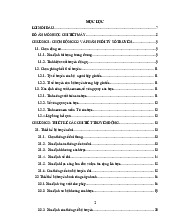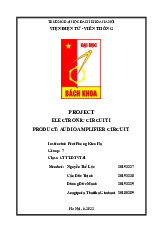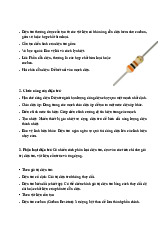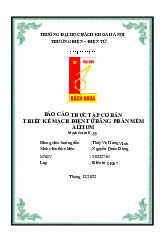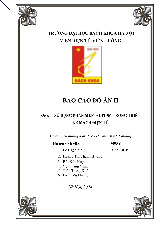


Preview text:
Tụ điện được sử dụng rộng rãi trong mạch điện tử để chặn dòng 1 chiều, trong khi
đó cho phép dong điện xoay chiều chạy qua. Trong mạng lọc, tụ điện dùng để làm
mịn đầu ra của nguồn cấp. hay dùng trong các mạch cộng hưởng để bắt tần số của
đài phát thanh. Và nhiều ứng dụng khác
Resistors are neither inherently "good" nor "bad"; their value depends on the
context and purpose for which they're used. Here's a breakdown of when resistors
are beneficial and when they might be problematic: Why Resistors Are Good
1. Control of Current: Resistors limit the flow of current in a circuit, which is
essential for protecting components like LEDs or transistors from excessive
current that could damage them.
2. Voltage Division: They are used in voltage divider circuits to provide
specific voltage levels to different parts of a circuit.
3. Energy Dissipation: Resistors dissipate electrical energy as heat, which can
be useful in applications like heaters or braking systems.
4. Signal Conditioning: They can shape or filter signals in conjunction with
capacitors and inductors, as seen in audio or communication circuits. Why
Resistors Might Be Considered Not Good
1. Energy Loss: In many applications, resistors dissipate energy as heat, which
can reduce the efficiency of the system. For instance, in power electronics,
energy loss in resistors is undesirable.
2. Limited Functionality: Resistors alone cannot amplify or generate signals;
they can only resist current, which limits their applications.
3. Heat Generation: High power resistors can become hot and require heat
management solutions, potentially increasing the size and complexity of a design. 1. Current Limiting •
LED Circuits: Protect LEDs by limiting the current to prevent damage. •
Motor Drivers: Control current supplied to motors. 2. Voltage Division •
Voltage Divider Circuits: Create reference voltages or divide a larger voltage into smaller ones. •
Sensor Interfacing: Scale down voltage signals for microcontrollers or ADCs. 3. Signal Conditioning •
Filters: Combine with capacitors and inductors in low-pass, high-pass, or bandpass filters. •
Pull-Up/Pull-Down Resistors: Stabilize input pins of digital circuits to avoid undefined states. 4. Heat Dissipation •
Power Supplies: Dissipate excess energy to stabilize circuits. •
Heaters: Generate heat in industrial applications.
5. Timing and Oscillation •
RC Circuits: Set timing intervals in circuits like clocks, timers, or delays. •
Oscillators: Work with capacitors and inductors to create waveforms. 6. Signal Processing •
Attenuators: Reduce the strength of a signal without distorting it. •
Volume Control: Used in audio equipment to adjust sound levels. 7. Protection •
Inrush Current Limiters: Protect circuits from surges during power-up. •
Snubber Circuits: Minimize voltage spikes in inductive loads like motors and relays.
8. Measurement and Feedback •
Current Sensing: Measure current using a resistor with known resistance (shunt resistor). •
Feedback in Amplifiers: Control gain and stabilize amplifier circuits. 9. Decoupling
Isolation: Separate parts of a circuit electrically to prevent interference.
